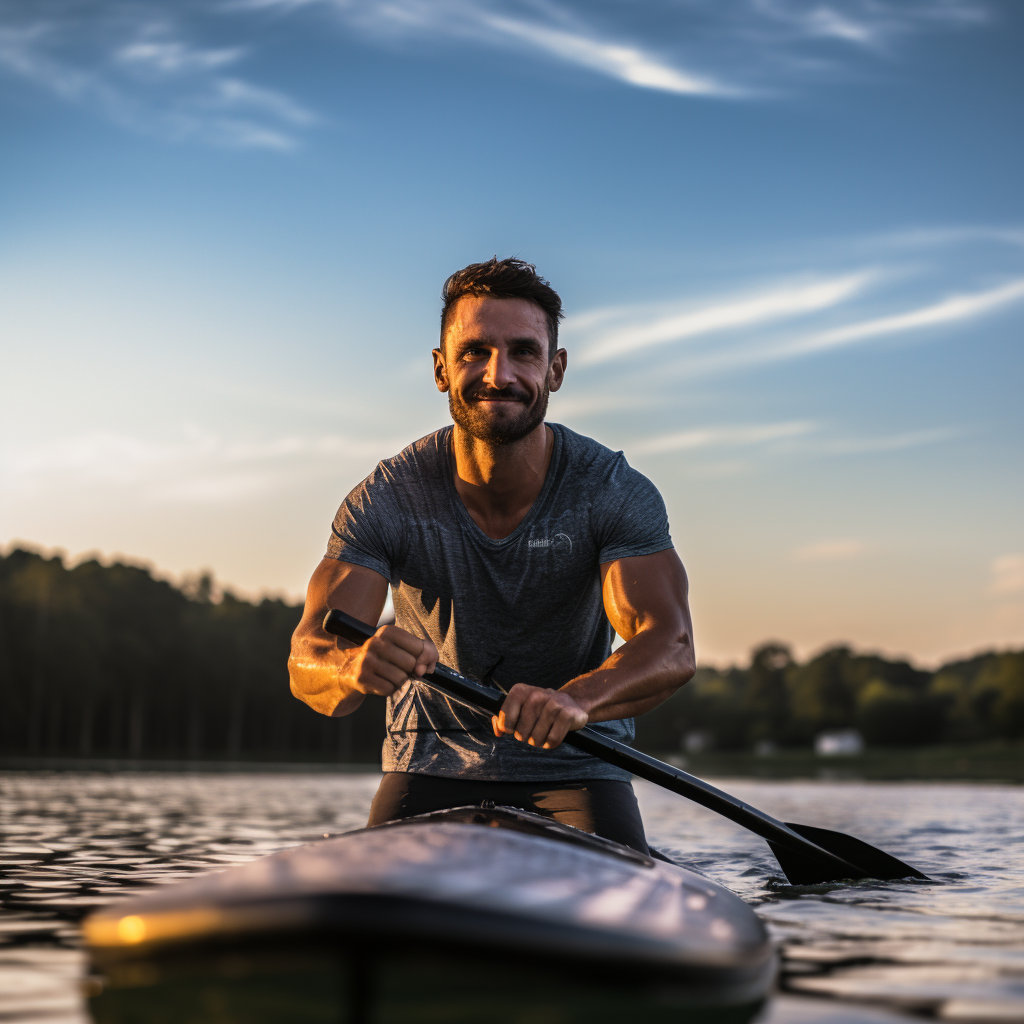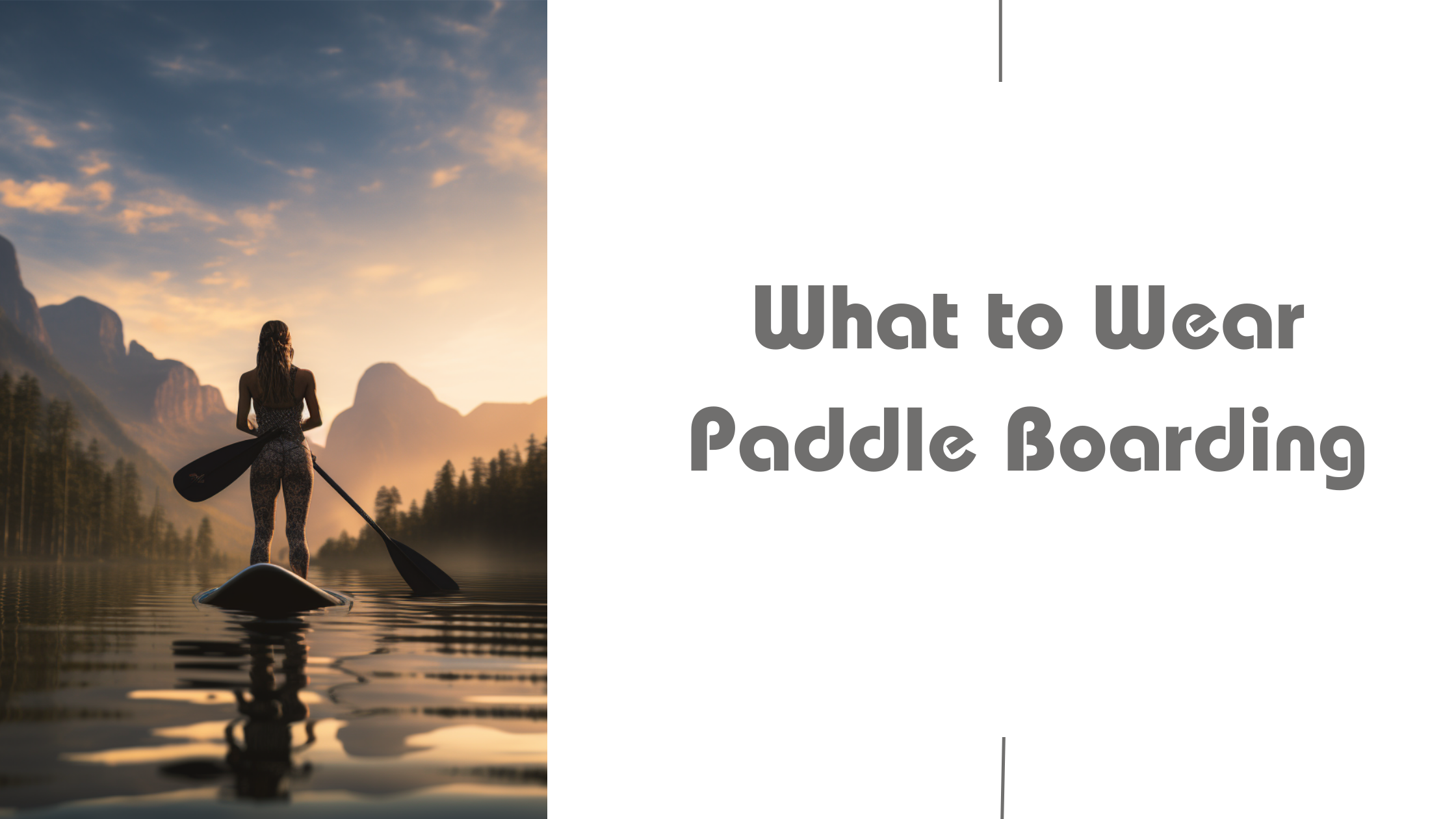The first question that often comes to mind when you first decide to take up paddle boarding is, “what should I wear?”
Understanding the essentials of paddleboarding attire is crucial. It’s not just about looking good, it’s also about ensuring comfort, safety, and functionality. Whether you’re a seasoned pro or a beginner, the right gear can make all the difference.
Join us as we dive deep into the world of paddle boarding apparel. From weather-appropriate clothing to safety gear, we’ve got you covered. Get ready to paddle with confidence and style as we unfold the secrets of dressing for paddle boarding success.
Contents
- 1 Is a wetsuit necessary for paddle boarding?
- 2 What type of footwear is best for paddle boarding?
- 3 Should I wear a hat while paddle boarding?
- 4 Do I need a life jacket for paddle boarding?
- 5 Is sunscreen necessary when paddle boarding?
- 6 What should I wear for cold weather paddle boarding?
- 7 Are gloves necessary?
- 8 What type of clothing is best for paddle boarding?
- 9 Conclusion: Dressing Right for Paddle Boarding
Is a wetsuit necessary for paddle boarding?

The necessity of a wetsuit for paddle boarding largely depends on the weather conditions and water temperature. In colder climates or during the winter months, a wetsuit can provide essential insulation to keep you warm. It’s not just about comfort; hypothermia is a real risk when you’re exposed to cold water for extended periods.
There are different types of wetsuits suitable for paddle boarding. A full suit covers your entire body and is ideal for colder conditions. A spring suit, which covers the torso but leaves the arms and legs exposed, is a good option for milder weather.
When choosing a wetsuit, consider the thickness. Wetsuits are typically available in thicknesses ranging from 2mm to 6mm. The colder the water, the thicker your wetsuit should be.
- 2-3mm: Suitable for water temperatures of 59-68°F (15-20°C)
- 3-4mm: Ideal for temperatures of 50-59°F (10-15°C)
- 4-5mm: Best for temperatures of 43-52°F (6-11°C)
- 5-6mm: Necessary for temperatures below 42°F (6°C)
However, in warm climates or during the summer months, a wetsuit may not be necessary. Instead, you could opt for a swimsuit, board shorts, or a rash guard. These options allow for maximum freedom of movement while still offering some protection from the sun and minor scrapes.
Remember, safety should always be your primary concern when you’re getting started paddle boarding. Therefore, consider the conditions and your comfort level before deciding whether to wear a wetsuit.
What type of footwear is best for paddle boarding?
When it comes to paddle boarding, the choice of footwear can significantly impact your overall experience.
Opting for the right type can enhance your balance, grip, and comfort on the board. Barefoot paddle boarding is a popular choice among enthusiasts as it allows for a direct connection with the board, enhancing balance and control.
However, in colder conditions or rough surfaces, protective footwear becomes essential. Water shoes are a great choice for their lightweight design and quick-drying material. They provide excellent grip on the board and protect your feet from sharp objects in the water.
Another viable option is neoprene boots. These are designed for colder environments, offering thermal protection while maintaining a good grip on the board. They also provide a snug fit, reducing the risk of slipping off during your paddle boarding session.
For rocky or coral-rich environments, consider reef booties. These provide excellent protection against sharp objects and are typically made of thick, durable material.
- Barefoot Paddle Boarding
- Water Shoes
- Neoprene Boots
- Reef Booties
Remember, the choice of footwear largely depends on the environment and personal preference. Regardless of the type you choose, ensure it offers a good grip, comfort, and protection to enhance your paddle boarding experience.
Should I wear a hat while paddle boarding?
Wearing a hat can be a game-changer as it provides protection from the sun’s harmful ultraviolet rays, which can be intense, especially when reflected off the water. A hat can also shield your eyes, improving visibility and reducing the risk of squint-induced headaches.
Opt for one with a wide brim for maximum sun protection. Materials that are lightweight and quick-drying are ideal for paddle boarding.
We also recommend a hat with a chin strap to prevent it from being blown away by the wind.
Remember, paddle boarding is a water sport, and there’s a high chance your hat might get wet. Therefore, a hat that retains its shape when wet is a good choice.
Additionally, color matters. Light colors, such as white or beige, reflect sunlight and keep your head cool. On the other hand, dark colors absorb heat and can make you feel hotter.
Paddle boarding is a fun and engaging water sport. While what you wear is a personal choice, a hat can provide comfort and protection, enhancing your overall experience. So, next time you hit the water, don’t forget to grab your favorite hat.
Do I need a life jacket for paddle boarding?
Paddle boarding, a popular water sport, requires a certain level of safety gear. One of the most important pieces of equipment is the life jacket. The U.S. Coast Guard classifies stand-up paddle boards as vessels, which means that if you’re beyond the swimming, surfing, or bathing area, you should have a life jacket with you.
However, the type of life jacket you wear can depend on the conditions. For calm, flat water paddle boarding, a Type III life jacket is typically recommended. This type of life jacket is comfortable, allows for a wide range of motion, and is perfect for activities where rescue would be quick.
On the other hand, if you’re paddle boarding in rough water or areas with fast-moving currents, a Type V life jacket is advisable. This type of life jacket has more buoyancy and is designed for more dangerous conditions.
Here are a few key considerations when choosing a life jacket for paddle boarding:
- Fit: The life jacket should fit snugly without restricting movement.
- Comfort: It should be comfortable enough to wear for extended periods.
- Visibility: Bright colors can make you more visible in the water.
Remember, wearing a life jacket not only increases your safety but also the safety of others around you. So, when planning your paddle boarding attire, make sure a life jacket is at the top of your list.
Is sunscreen necessary when paddle boarding?
Absolutely, sunscreen is an essential part of your paddle boarding gear. When you’re out on the water, the sun’s rays are not only coming from above, but they’re also reflecting off the water’s surface, increasing your exposure to harmful UV radiation. This can lead to sunburn, premature skin aging, and even skin cancer.
Using a high-SPF, water-resistant sunscreen is highly recommended. It’s important to apply it generously on all exposed skin, including your face, neck, ears, and the back of your hands. Don’t forget areas like the underside of your chin and the tops of your feet, which can easily get burned while you’re standing on your paddle board.
Remember to reapply sunscreen every two hours, or immediately after swimming or sweating. Even if you’re wearing a long-sleeved rash guard or a hat, sunscreen is still necessary as UV rays can penetrate through certain fabrics.
Aside from sunscreen, wearing protective clothing such as a rash guard, hat, and sunglasses can also help shield your skin from the sun. Opt for rash guards with a UPF (Ultraviolet Protection Factor) rating for the best protection.
If you’re planning to paddle board for extended periods, consider using a sunscreen stick for easy reapplication, or a lip balm with SPF to protect your lips.
While it’s important to enjoy the beauty and serenity of paddle boarding, always prioritize your skin’s health by wearing sunscreen.
What should I wear for cold weather paddle boarding?
When you’re planning to hit the water for some cold weather paddle boarding, the key is to dress in layers. Start with a moisture-wicking base layer to keep you dry. This could be a thermal or synthetic fabric designed to pull sweat away from your skin. Over this, you should wear an insulating mid-layer, such as a fleece or wool sweater, to retain body heat. The outermost layer should be a waterproof and windproof shell to protect you from the elements.
Neoprene wetsuits are also a popular choice for cold weather paddle boarding. These suits provide excellent insulation and are designed to retain warmth even when wet. A thickness of 5mm to 6mm is recommended for colder conditions. Don’t forget to pair your wetsuit with neoprene boots, gloves, and a hood for maximum protection.
Here are some additional tips on what to wear:
- Choose bright colors or patterns for visibility.
- Always wear a personal flotation device (PFD).
- Protect your eyes with polarized sunglasses.
- Wear a hat or cap for added warmth.
Remember, staying warm and dry is crucial when paddle boarding in cold weather. By dressing appropriately, you can ensure a comfortable and enjoyable experience on the water.
Are gloves necessary?
Gloves can provide a solid grip, preventing the paddle from slipping out of your hands, especially when they’re wet or sweaty. This grip enhancement is particularly beneficial for longer paddle boarding sessions, where fatigue might set in.
Gloves also offer protection against blisters and calluses, which are common issues for avid paddle boarders. They offer a layer of padding that reduces friction between your hands and the paddle, making your ride more comfortable.
However, the necessity of gloves for paddle boarding can be subjective. Some paddle boarders prefer the direct contact with the paddle, claiming it offers better control. Others find gloves unnecessary in warm weather conditions, as they can make hands hot and sweaty.
• Material: If you decide to wear gloves, ensure they are made of quick-drying, breathable fabric. Neoprene gloves are a popular choice due to their durability and water-resistant properties.
While gloves are not a mandatory part of paddle boarding attire, they can enhance your experience by improving grip, protecting your hands, and providing comfort during long sessions.
Ultimately, the decision to wear gloves for paddle boarding depends on your personal preference and comfort.
What type of clothing is best for paddle boarding?
When it comes to paddle boarding, the choice of clothing is crucial to ensure comfort, safety, and performance. The ideal attire should be lightweight, quick-drying, and offer protection against the sun and water elements.
A popular choice among paddle boarders are the synthetic materials like nylon and polyester. These fabrics are not only lightweight but also quick-drying, which is vital when you’re out on the water. They also provide excellent protection against harmful UV rays, which is a significant concern for paddle boarders.
Wearing a wetsuit or a drysuit can be beneficial, especially in colder climates. A wetsuit is designed to keep you warm by trapping a thin layer of water between your skin and the suit, which your body heats. On the other hand, a drysuit is designed to keep you dry, making it the perfect choice for extremely cold conditions.
For your feet, water shoes or sandals with a good grip are recommended. They not only protect your feet but also provide excellent traction on the slippery paddle board.
When selecting your paddle boarding attire, remember that comfort and functionality should be your top priorities. The right clothing will not only enhance your performance but also make your paddle boarding experience more enjoyable and safe.
Conclusion: Dressing Right for Paddle Boarding
In summary, there are several key considerations when deciding what to wear paddle boarding. The choice of attire ultimately depends on the weather, water temperature, and your personal comfort. Wetsuits can provide warmth and buoyancy, but they’re not always necessary. Footwear such as water shoes can add grip and protect your feet. A hat can shield you from the sun, and a life jacket is a crucial safety measure, especially for beginners.
Sunscreen is indispensable for paddle boarding to protect your skin from harmful UV rays. Cold weather paddle boarding requires additional layers to maintain body heat, and gloves can protect your hands from cold and blisters. The type of clothing best suited for paddle boarding is generally lightweight, quick-drying, and offers sun protection.
Remember, the right attire can make your paddle boarding experience more enjoyable and safer. As paddle boarding continues to grow in popularity, we can expect to see advancements in gear and clothing designed specifically for this sport. Always stay updated and make informed choices to enhance your paddle boarding experience. Happy paddling!

